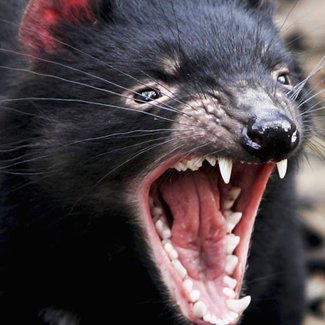Why Did The Tasmanian Devil Go Extinct In Australia
Over 2000 bounties were paid by the government between 1888 to 1909 to eradicate the species. However there were times when they lived all over Australia.

Tassie Devils And Thylacines Went Extinct From The Mainland At The Same Time Australian Geographic
As for what caused the extinction of these two animals scientists are still unsure however Jeremy says that there are three main theories.

Why did the tasmanian devil go extinct in australia. They are widespread and common in Tasmania but are not found on Bass Strait Island. Unfortunately today Tasmanian devils can be found only on this island. It is estimated that fewer than 25000 Tasmanian devils still live in the wild down from as many as 150000 before the mysterious fatal disease first struck in the mid-1990s.
In 2008 it was listed as an endangered species by the IUCN Red List. A small population of thylacines persisted on Tasmania when Europeans arrived in Australia. There is an estimated 25000 still in the wild today with the majority of them being located in Tasmania south of Australia.
Extinction of thylacine. Discovering the little animals with such big sharp teeth prompted them to call it The Devil. The animals -- known for their extremely loud growl powerful jaws and ferocity when confronting rivals over food or mates -- are classified as endangered after a.
Its been 3000 years since the Tasmanian devils raspy shriek rang through the forests of mainland AustraliaBut now thanks to a dogged reintroduction effort 26 of these endangered tiny. As the largest carnivorous marsupial species Tasmanian devils vanished from the mainland about 3000 years ago but survived in Tasmania. On 7 September 1936 only two months after the species was granted protected status Benjamin the last known thylacine died from exposure at the Beaumaris Zoo in Hobart.
Its decline and extinction in Tasmania was probably hastened by the introduction of dogs but appears mainly due to direct human persecution as an alleged pest. While it is estimated there were around 5000 thylacines in Tasmania at the time of European settlement. Another reason why their numbers are so low is because in the early 20th century the Tasmanian devils nearly reached extinction due to hunting and trapping but they recovered due to the Australian law saying that we had to protect the species.
The Thylacine became extinct on the Australian mainland not less than 2000 years ago. Eleven Tasmanian Devils are being reintroduced into an Australian wildlife sanctuary north of Sydney. It is thought that they became extinct from the mainland about 400 years ago.
Catch up on the developing stories making headlines. Though scientific research claimed that the major livestock killer during that era was actually wild dogs Tasmanian wolves were still blamed and became the scapegoat for the dogs during that time. On Australias mainland they are believed to have been wiped out by packs of dingoes wild dogs native to the vast continent an estimated 3000 years ago.
After that the Tasmanian devil will develop the symptomatic facial tumors. However excessive hunting combined. Habitat fragmentation prevents the species from breeding effectively and therefore may reduce repopulation rates.
The less area they have to live in the lower their population can be. As their name suggests the Tasmanian devils live on the island of Tasmania on the south coast of Australia. The first is that climate change specifically the sudden increase in ENSO activity around 4000-6000 years ago may.
The Tasmanian Devil is currently listed by the World Wide Fund for Nature WWF as critically endangered. The government even offered bounties for hunting Tasmanian wolves. Tasmanian Devils were once abundant on mainland Australia as evidenced by fossil remains.
The research will rely on genetic procedures to examine the impact of an infectious cancer devil facial tumor disease on Tasmanian devils. Its believed they became extinct on the mainland about 3000 years ago possibly due to increasing numbers of dingoes. Habitat loss is relatively self-explanatory.
As the tumors metastasize they may destroy the devils jaw and cause their teeth to deteriorate. There are multiple reasons why this species is becoming endangered and these will be discussed soon but the most critical reason why Tasmanian devils are facing the prospect of becoming extinct is because of the deadly Devil Facial Tumor Disease DFTD. A contagious cancer wiped out about 90 of the marsupials in recent years.
The government bounty may. In a giant step forward for the Tasmanian devil the iconic species has been reintroduced to Australias mainland in a protected disease-free area The Guardian reported. However they have declined in the latter in recent decades due to an.
Unfortunately Tasmanian devils arent any more immune to this than any other species. Eventually the animals lose their ability to eat and starve to death. With no dingoes found in Tasmania the Tasmanian devil is now the island states top predator.
It is now only found in Tasmania. A sudden decline in the thylacine population was reported in the early 1900s and the species was declared extinct in 1936. Tasmanian devils once called Sarcophilus satanicus or satanic flesh-lover went extinct in mainland Australia before the arrival of Europeans on the continent.
Hunting is what made Tasmanian devils go extinct everywhere else except for the Tasmanian island. The devil became extinct on the mainland some 3000 years ago before European settlement due to being hunted by the Dingo. Between 1888 to 1908 over 2000 Tasmanian wolves were killed in hunts.
Tassie Devils once lived on the mainland of Australia. The species was rapidly viewed as a pest and a dangerous threat to livestock though many of these claims were highly exaggerated.

Are Tasmanian Devils Fighting Their Way To Extinction Howstuffworks
Belum ada Komentar untuk "Why Did The Tasmanian Devil Go Extinct In Australia"
Posting Komentar